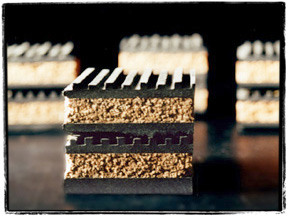You are reading the older HTML site
Positive Feedback ISSUE
september/october 2008
The Sound of Maple: What's under your amps?
by Bob Neill
A couple of years ago, I praised the virtues of Mapleshade's Samson equipment rack, which is simply (!) Pierre Sprey's handsome and wonderfully effective two-inch maple platforms locked into a vertical structure (though mine, by choice is more horizontal) by steel rods and brass 'washer/nuts' and brass footers. (https://positive-feedback.com/Issue14/mapleshadesamson.htm) What I hear mainly from my Samson (I now own two) is mainly increased ease. Though I did not notice it right away, I also soon became aware of additional firmness, authority, and natural warmth, which is what most Samson fans hear first. The late Backwoods Barry heard some of that from his thick maple cutting boards, which is what got me started on Mapleshade. Barry was too frugal for Pierre's stuff.
What I didn't report on in my Samson review was to what extent its virtues were captured by the stand-alone Mapleshade two-inch platforms with Isoblocks that I put under my Audio Note Neiro monoblocks. Isoblocks are sandwich gizmos that isolate the platforms from the floor. (See image.) I tried brass cones under the platforms (and under the amps) and did not much like them in either location. Brass cones are an acquired taste, which to my finicky ears increase focus at the expense of ease. Under a full Samson, where Isoblocks are unthinkable (too much weight for them), brass footers—the fat ones—seem to do fine.

Now that I've added two more shelves, under my new 85-pound Blue Circle BC204 stereo amp and its separate GZpz (yeah, I know, but it's Gilbert's name for it, not mine) power supply, I think maybe the time has come to say something more. Before the new Mapleshade platforms and their Isoblocks arrived, I had the BC204 with its integral MDF base (which makes Pierre's eyes roll up into his head) sitting on two-inch foam and the GZpz on the floor. Gilbert swears by the MDF, says the 204 sounds lean and hollow without it. It would have been interesting to find a way to remove it and set the amp directly on the maple, but I decided not to challenge Gilbert on this point. His track record on what makes his gear sound right is perfect. So as I proceeded to the next step, Pierre would doubtless have wanted to put an asterisk on my observations! Fair enough. (I should note that he would also doubtless have preferred that I used four-inch rather than two-inch platforms.)
So I put the amp cum MDF on the (two-inch) maple and set it on the Isoblocks, and what change(s) did I hear? As with the platforms under my Neiros in the my Audio Note system, Anne Gastinel's cello as she played in my Blue Circle/JM Reynaud system had a bit (but an audible bit) more authority and an equal bit more bounce. I know the goal here is to hear the amp kicking off maple and off nothing else, which is what the Isoblocks are for. And I'm pretty confident that's what I hear. I recognize the effect resulting from the addition of the platforms under the Neiros. It's entirely possible I would hear more of this were the amp sitting directly on the maple as the Neiros do. Perhaps Gilbert and I will play that game some day. Gilbert says that no one has yet found a way to set the amp up so that really significant differences (plus or minus) occur. We'll see what he says on his next visit. Doing a series of A/B comparisons with an 85-pound amp won't be a whole lot of fun, but I think we owe it to Mapleshade. (My wife will have none of it: she hasn't lifted a piece of audio gear since we both nearly broke our backs with a 200 watt Audio Research power amp ten years ago!) For now, let's just say things got somewhat better in the expected Mapleshade ways. But let's also say things got a LOT better looking. Mapleshade's lacquered maple platforms are extremely handsome. And two inches of foam are really ugly. How about the GZpz? If there's difference there, it's too subtle for my ears. I put a block under it because it's worked everywhere else and looks good. I'll confess to doing some things on faith and for consistency and also for looks, if the cost isn't too high.
So Mapleshade remains my favorite support system for audio gear. I know that there are other approaches, featuring less weight and more isolation. I've heard a few of them over the years and found none objectionable. But to my ears, none of them actually made a system sound so audibly better as Mapleshades's maple-based system.
Systems used for this review.
Audio Note system:
-
Audio Note CDT3 transport and Dac 4.1 Balanced Signature
-
Audio Note M6 tubed Phono preamplifier
-
Audio Note Neiro 2A3 tubed monoblocks.
-
Audio Note E/SPx SE speakers on Audio Note speaker stands
-
Audio Note Pallas, Sogon, and Vx interconnects, SPx speaker cable
Blue Circle/Jean Marie Reynaud system:
-
Audio Note front end.
-
Blue Circle BC 3000 GZpz preamplifier
-
Blue Circle BC204 hybrid stereo amplifier
-
JM Reynaud Orfeo loudspeakers on Symposium Sveltes.
-
Audio Note Pallas, Sootto, and Sogon interconnects, Lexus speaker cable.
-
Blue Circle BC6000 Line Conditioner
Bob Neill, in addition to being an occasional equipment and regular music reviewer for Positive- Feedback Online, is also proprietor of Amherst Audio in Amherst, Massachusetts, which sells equipment from Audio Note, Blue Circle, and JM Reynaud, among others.
